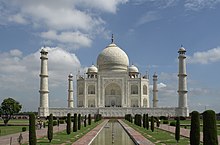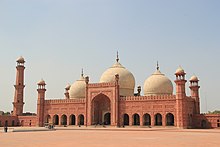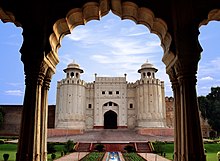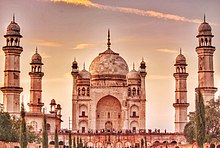莫卧儿建筑




莫卧儿建筑是莫卧儿帝国16至18世纪发展形成的一种印度伊斯兰教式建筑,它融合了此前伊斯兰建筑、伊朗式建筑、突厥建筑和印度建筑,知名建筑包括阿格拉堡、法泰赫普尔西克里及泰姬陵、蒙兀兒花園。[2][3][4][5][6] 它还进一步吸收了更广泛的印度建筑的影响,特别是在阿克巴统治时期 (1556–1605)。[2][3][5][6] 莫卧儿建筑具有统一的结构和特征模式,包括巨大的球形穹顶、角落里细长的尖塔、巨大的大厅、大型拱门和精致的装饰;在现代的阿富汗、孟加拉国、印度和巴基斯坦都能找到这种风格的例子。
莫卧儿王朝在第一次帕尼帕特战役的胜利后建立。在他五年的统治期间,巴布尔对建造建筑产生了相当大的兴趣,尽管现存的建筑很少。他的孙子阿克巴广泛建造,在他统治期间,这种风格得到了大力发展。他的成就包括阿格拉堡、法泰赫普尔西克里的堡垒城市和胜利之门。阿克巴的儿子贾汉吉尔建造了克什米尔的沙利玛尔花园。
莫卧儿建筑在沙贾汉统治时期达到顶峰,他建造了泰姬陵、贾玛清真寺、沙利马尔花园、瓦齐尔汗清真寺,并翻新了拉合尔堡。最后一位伟大的莫卧儿建筑师是奥朗则布,他建造了巴德夏希清真寺、夫人之墓、珍珠清真寺等等。
特征

莫卧儿建筑融合了印度建筑元素与伊朗式建筑和伊斯兰元素。许多建筑的一些共同特征是:
- 巨大的球状洋蔥形圓頂,有时由四个较小的圆顶包围。
- 使用白色大理石和红色砂岩。
- 使用精致的装饰品,包括帕钦卡里'装饰品和'贾里'格子屏幕。
- 纪念性建筑四面都有花园环绕。
- 有大院子的清真寺。
- 波斯和阿拉伯文书法的铭文,包括古兰经的诗句。
- 通往主楼的大门洞。
- 伊万在两边或四边。
- 使用装饰性的恰特里。
- 使用贾里和贾罗卡。
莫卧儿建筑也影响了后来的印度建筑风格,包括英属印度的印度撒拉逊风格、拉杰普特风格和锡克教风格。
| ||||||||||||||||||||||||||||||||||||||||||||||
| |||||||||||||||||||||||||||||||||||||||||||||||||||||||||||||||||||||||||||||||||||||
- ^ Taj Mahal World Heritage. UNESCO World Heritage. Centre. [2018-12-31]. (原始内容存档于2019-02-01) (英语).
- ^ 2.0 2.1 Asher 1992,第1-2頁.
- ^ 3.0 3.1 Petersen, Andrew. Mughals. Dictionary of Islamic architecture. Routledge. 1996: 199–205. ISBN 9781134613663.
- ^ M. Bloom, Jonathan; S. Blair, Sheila (编). Architecture; VII. c. 1500–c. 1900; D. India.. The Grove Encyclopedia of Islamic Art and Architecture. Oxford University Press. 2009. ISBN 9780195309911.
- ^ 5.0 5.1 Vaughan, Philippa. Indian Subcontinent: from Sultanate to Mughal Empire. Hattstein, Markus; Delius, Peter (编). Islam: Art and Architecture. h.f.ullmann. 2011: 464–483. ISBN 9783848003808.
- ^ 6.0 6.1 Asher, Catherine B. Mughal architecture. Fleet, Kate; Krämer, Gudrun; Matringe, Denis; Nawas, John; Rowson, Everett (编). Encyclopaedia of Islam, Three. Brill. 2020. ISSN 1873-9830.
Text is available under the CC BY-SA 4.0 license; additional terms may apply.
Images, videos and audio are available under their respective licenses.

